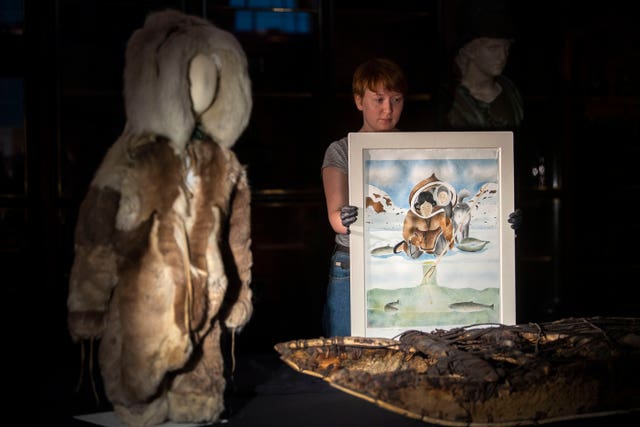Objects buried for thousands of years will be seen for the first time after emerging in melting Arctic ice.
The “treasures”, some almost 30,000 years old, will be seen at a British Museum exhibition, Arctic: Culture And Climate.
The museum has been criticised for its sponsorship arrangements with BP but the new exhibition is funded with investment bank Citi.

Items discovered in permafrost include carved mammoth ivory necklaces, “beautiful” bone needles, spears and fragments of a bracelet made from walrus bone.
Headbands have also been found, as well as parts of a 9,000-year-old willow and birch basket – the oldest basket to be found in the Arctic, used for collecting berries, seaweed and plants.
Some of the finds are 28,000 years old and were excavated from the thawing ground in Siberia.
Exhibition curator Jago Cooper said the story behind the emergence of the “treasure trove” was “tragic”.
“As the Arctic is melting, the permafrost, the frozen ground, is melting as well.
“The things that people were living with in that landscape, which are incredibly well preserved in that frozen ground, are coming out as the ground is melting.”
Archaeologists have to find the objects before they “disappear on the surface of the earth because they are exposed” to the elements.
He said: “It’s like the Library of Alexandria being on fire… You’re plucking out these books which are coming out, yes it’s a remarkable window into life, all coming out of the ground in one go.”
Necklaces and brooches have been discovered at an “absolutely extraordinary” human settlement, dating back around 30,000 years.
“People are learning a lot more about the fantastic wonder of those objects created so long ago,” Cooper said.
Climate change is transforming the Arctic at the fastest rate in human history, with it “changing before our very eyes”, curators said.
The Arctic is home to four million people, including 400,000 indigenous peoples.
Climate scientists predict Arctic summers will be without ice in 80 years.
The exhibition will look at changes over hundreds of years, including European and Russian exploration to the region, quests for the Northwest Passage and the global fur trade.
It will also examine the region through the eyes of today’s Arctic communities.
Campaigners have criticised the British Museum for holding an exhibition on the Arctic, while still taking money from BP.
The Citi exhibition Arctic: culture and climate opens 28 May – book early bird tickets: https://t.co/BVelxTf23K
Lead supporter Citi
Supported by Julie and Stephen Fitzgerald
Supported by AKO Foundation pic.twitter.com/dhYLb1ipdk
— British Museum (@britishmuseum) January 9, 2020
Chris Garrard, co-director of Culture Unstained, said in a statement to the PA news agency: “BP’s logo has been cynically kept away from this exhibition in order to avoid further damage to the museum’s reputation.
“The museum clearly accepts that BP has a dire record on climate change but will go on giving its backing to the oil firm, which remains 97% invested in fossil fuels.
“While the museum’s decision-makers pick and choose when to take climate action, Indigenous communities in the Arctic have been leading the struggle against the fossil fuel industry’s drilling for decades – and are now also the ones facing growing climate impacts.”
Asked whether it was hypocritical to have an exhibition on climate change while having other exhibitions sponsored by BP, British Museum director Hartwig Fischer, said: “I don’t think it’s contradictory.
“We are all exposed to the challenges and have to think together, how to find the right solution, to mitigate the effects of these changes. We have all contributed to these changes…
“We have to think together about what changes are necessary.”
The exhibition will look at the Arctic and the indigenous peoples “through the lens of climate change and weather”.
Objects on display will also include an Igloolik winter costume made of wild reindeer fur, a “beautiful” bag crafted from tanned salmon skin and a spirit mask.
A sled made from narwhal and caribou bone and pieces of driftwood, marking the first encounter between Inughuit and Europeans, will also go on show.
The Citi Exhibition: Arctic: Culture And Climate will run from May 28 to August 23 at the British Museum.
